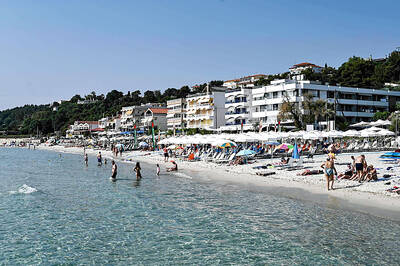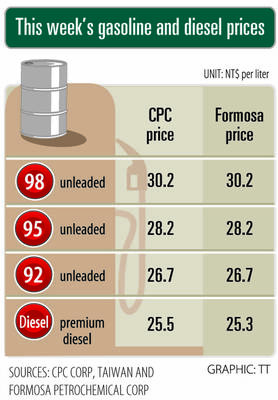Global goods trade is on course for modest growth throughout this year and next year, despite risks emanating from the conflict in the Middle East, the WTO forecast yesterday.
“We are expecting a gradual recovery in global trade for 2024, but we remain vigilant of potential setbacks — particularly the potential escalation of regional conflicts like those in the Middle East,” WTO Director-General Ngozi Okonjo-Iweala said in a statement.
“The impact could be most severe for the countries directly involved, but they may also indirectly affect global energy costs and shipping routes.”

Photo: Martial Trezzini, EPA-EFE
Global goods trade slumped 1.1 percent last year, depressed by high inflation and rising interest rates.
In its updated global trade outlook, the WTO revised its forecast for world merchandise trade growth this year to 2.7 percent — slightly up from the April estimate of 2.6 percent.
Demand for traded goods is stronger than foreseen in Asia and weaker than expected in Europe, it said.
The WTO lowered its next year’s forecast from 3.3 percent to three percent.
WTO chief economist Ralph Ossa told AFP that while there are “risks everywhere” for international trade, “the biggest one would be the geopolitical risk” from conflict in the Middle East.
“If, for example, the oil price rises dramatically, this would of course affect the economy and trade,” he said.
However, “it seems that at the moment the markets can’t quite decide if they should be concerned about the supply side risks coming from the Middle East, or what they should think about the demand side coming from China.”
Asia’s export volumes are set to grow faster than any other region this year, rising as much as 7.4 percent, driven by China, Singapore and South Korea, with Japanese exports stagnant.
On the import side, Chinese import growth remains moderate, while Singapore, Malaysia and other Asian economies are showing stronger growth.
Meanwhile, Europe is now expected to post a decline of 1.4 percent in export volumes this year. Imports are forecast to decrease 2.3 percent.
“We see Europe weaker than we expected and Asia stronger than we expected, with Europe continuing to be a drag on export and import growth, and Asia continuing to be a driver, particularly of exports,” Ossa said.
For Europe, “a big part of the story is Germany,” he said, citing lower car and chemical exports, particularly in organic chemicals and those used in vaccine production.
Germany’s crucial manufacturing sector has been hit hard by higher energy costs in the wake of Russia’s war in Ukraine and cooling demand from abroad, contributing to a wider downturn.
The WTO outlook highlighted the rising importance of so-called “connector countries” in global supply chains and trade, particularly Mexico and Vietnam, followed by India.
While the direct bilateral trade relationship between China and the US has “really suffered,” much trade now seems to be being routed via such countries, Ossa said.
The WTO hopes the normalization of inflation and interest rates will bolster international trade.
“As the impact of inflation recedes, we should expect to see incomes recovering and consumption of all kinds of goods rising, including imports,” WTO senior economist Coleman Nee said.
World real GDP growth at market exchange rates is expected to remain steady at 2.7 percent last year, this year and next.
The fastest-growing region this year is likely to be Asia, where output is expected to climb to four percent, while the slowest-growing region is likely to be Europe at 1.1 percent.

Greek tourism student Katerina quit within a month of starting work at a five-star hotel in Halkidiki, one of the country’s top destinations, because she said conditions were so dire. Beyond the bad pay, the 22-year-old said that her working and living conditions were “miserable and unacceptable.” Millions holiday in Greece every year, but its vital tourism industry is finding it harder and harder to recruit Greeks to look after them. “I was asked to work in any department of the hotel where there was a need, from service to cleaning,” said Katerina, a tourism and marketing student, who would

i Gasoline and diesel prices at fuel stations are this week to rise NT$0.1 per liter, as tensions in the Middle East pushed crude oil prices higher last week, CPC Corp, Taiwan (台灣中油) and Formosa Petrochemical Corp (台塑石化) said yesterday. International crude oil prices last week rose for the third consecutive week due to an escalating conflict between Israel and Iran, as the market is concerned that the situation in the Middle East might affect crude oil supply, CPC and Formosa said in separate statements. Front-month Brent crude oil futures — the international oil benchmark — rose 3.75 percent to settle at US$77.01

Merida Industry Co (美利達) has seen signs of recovery in the US and European markets this year, as customers are gradually depleting their inventories, the bicycle maker told shareholders yesterday. Given robust growth in new orders at its Taiwanese factory, coupled with its subsidiaries’ improving performance, Merida said it remains confident about the bicycle market’s prospects and expects steady growth in its core business this year. CAUTION ON CHINA However, the company must handle the Chinese market with great caution, as sales of road bikes there have declined significantly, affecting its revenue and profitability, Merida said in a statement, adding that it would

UNCERTAINTIES: The world’s biggest chip packager and tester is closely monitoring the US’ tariff policy before making any capacity adjustments, a company official said ASE Technology Holding Inc (日月光投控), the world’s biggest chip packager and tester, yesterday said it is cautiously evaluating new advanced packaging capacity expansion in the US in response to customers’ requests amid uncertainties about the US’ tariff policy. Compared with its semiconductor peers, ASE has been relatively prudent about building new capacity in the US. However, the company is adjusting its global manufacturing footprint expansion after US President Donald Trump announced “reciprocal” tariffs in April, and new import duties targeting semiconductors and other items that are vital to national security. ASE subsidiary Siliconware Precision Industries Co (SPIL, 矽品精密) is participating in Nvidia